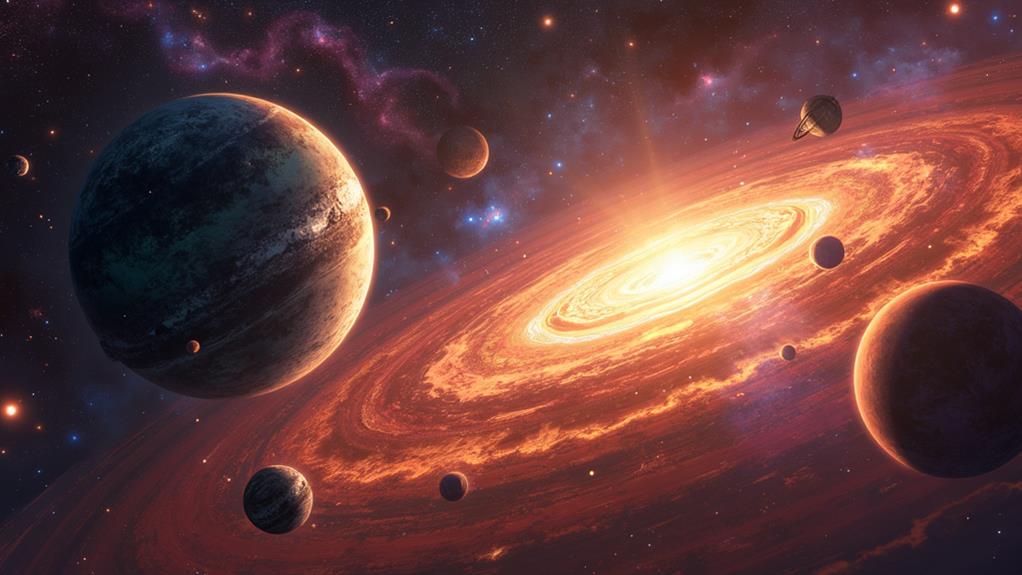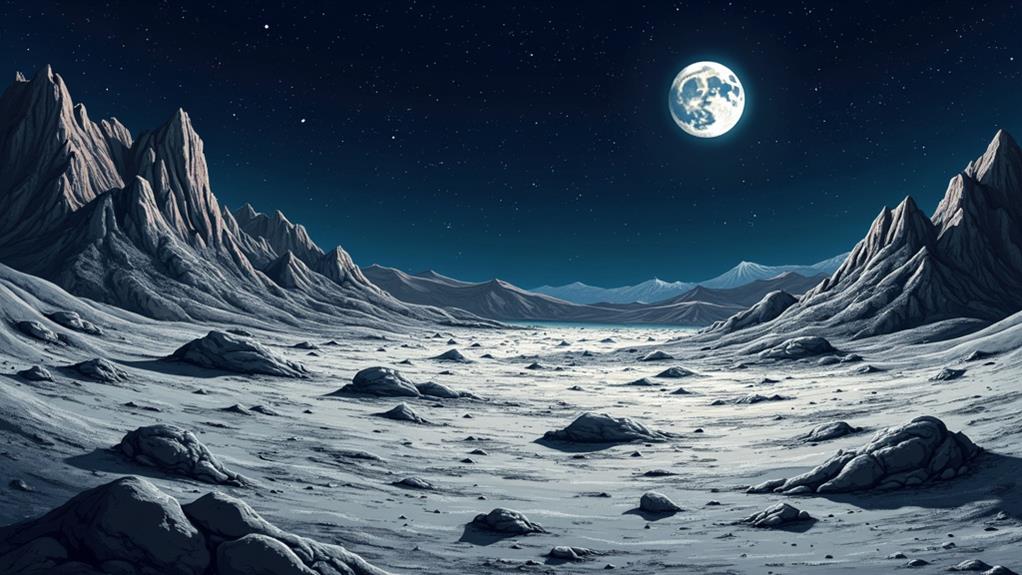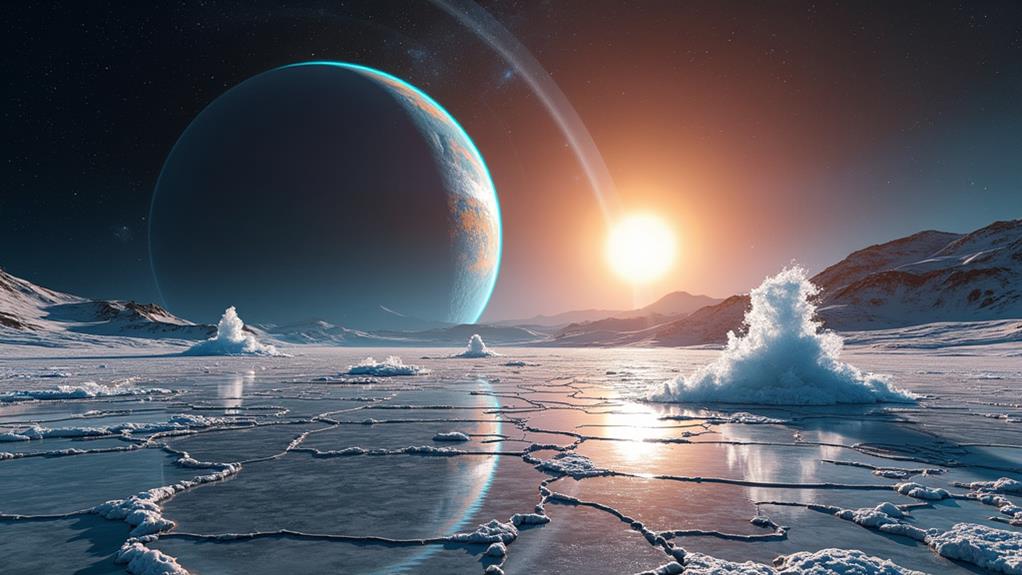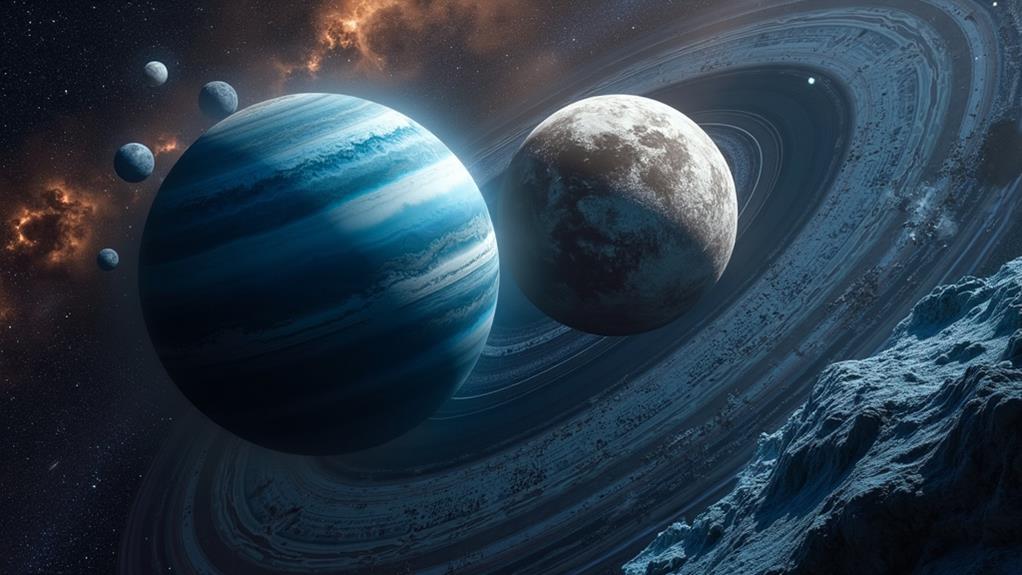Why Do Dwarf Planets Have Unique Moons?
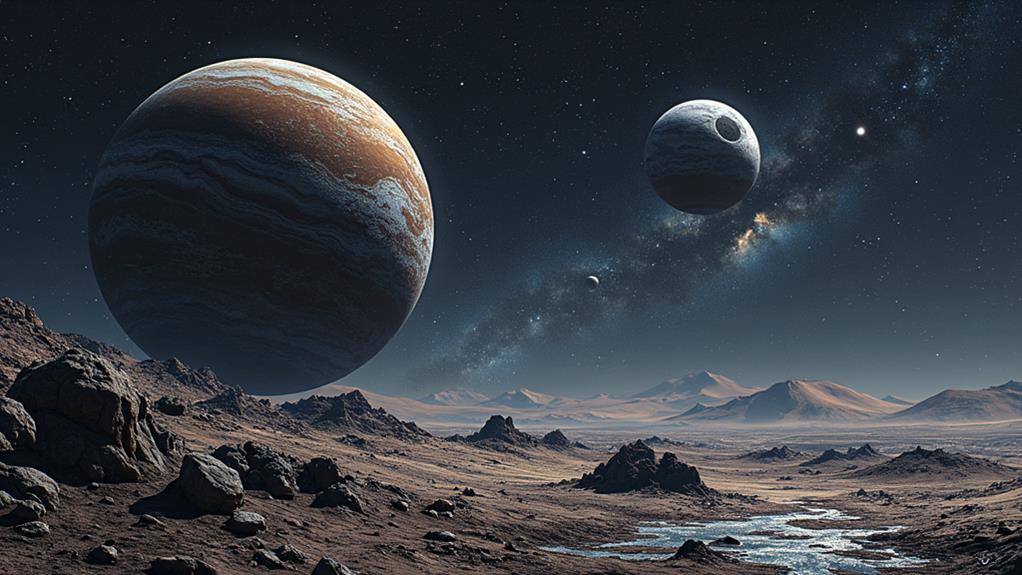
Dwarf planets have unique moons because of their unusual formation processes and distinct gravitational influences. These moons can form from debris after colossal collisions, like Pluto's Charon, or get captured by the planet's gravity, such as Eris's moon Dysnomia. Their diverse compositions, often icy and rocky, reflect the materials in the outer solar system's Kuiper Belt. Unlike major planets, these moons frequently exhibit irregular orbits and intriguing geological features. Investigating these unique characteristics uncovers fascinating insights into solar system dynamics and planetary evolution, offering more to examine about the origins of these celestial bodies.
Key Takeaways
- Dwarf planets' moons often form from colossal collisions, creating unique characteristics compared to moons of larger planets.
- Gravitational capture allows dwarf planets to snatch nearby objects, leading to diverse and irregular moon compositions.
- The Kuiper Belt's influence on dwarf planets introduces additional gravitational complexities, affecting moon formation and orbits.
- Dwarf planet moons display unique icy and rocky compositions, indicating a variety of materials in their regions.
- Lower mass and gravitational influences of dwarf planets result in less predictable and more eccentric moon orbits.
Formation of Dwarf Planet Moons
In the formation of dwarf planet moons, there are several intriguing processes at play. These moons often come into existence through mechanisms similar to their parent dwarf planets. One primary method is accretion from the protoplanetary disk, where dust and gas gradually coalesce to form moons. Another significant process is the result of colossal collisions, which eject debris into orbit around the dwarf planet. For instance, Pluto's moon Charon is believed to have formed from such an impact, echoing theories about Earth's Moon.
Gravitational capture is another fascinating mechanism. In this scenario, a dwarf planet can snatch a nearby object into its orbit. Eris's moon Dysnomia is a prime example of this process. These captured moons often reflect the diverse conditions and materials present in the Kuiper Belt, the region where many dwarf planets reside. For example, Haumea's moons possess unique icy compositions, hinting at the varied materials available during their formation.
Ongoing research and simulations highlight how these formation processes are influenced by gravitational interactions with other celestial bodies. These dynamics play a vital role in the stability and evolution of moons around dwarf planets, showcasing the complexity of their origins.
Gravitational Influences
Gravitational influences play an essential role in shaping the moons of dwarf planets. You might wonder how these smaller celestial bodies manage to retain moons despite their relatively low mass. The answer lies in the gravitational interactions and capture mechanisms at work. For dwarf planets like Pluto and Eris, their weaker gravitational fields make them more reliant on these processes to acquire and maintain moons.
Consider these factors:
- Gravitational Interaction: The mass of a dwarf planet influences its ability to hold onto moons. Haumea, with its significant mass and rapid rotation, can support multiple moons.
- Orbital Dynamics: The irregular orbits of some moons, such as Charon's synchronous orbit with Pluto, highlight the complex gravitational dynamics involved.
- Gravitational Capture: Dwarf planets can capture passing objects into their orbits, leading to the formation of moons. This process is vital for those with weaker gravitational fields.
- Hill Sphere Radius: This radius determines the limit within which a dwarf planet can retain a moon before the Sun's gravity takes over, impacting the stability of these moons.
Orbital Dynamics
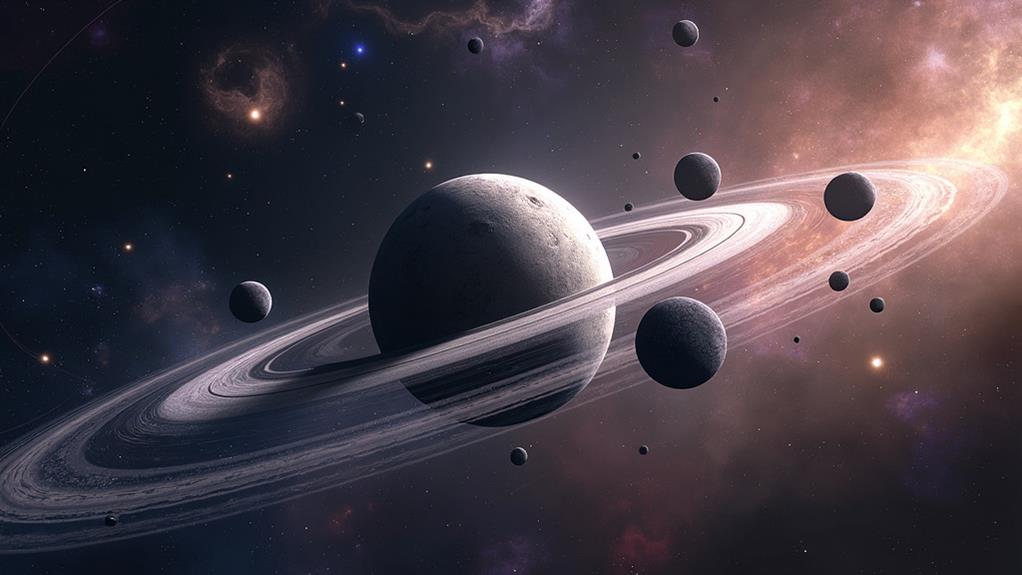
Orbiting a dwarf planet isn't as straightforward as you might think. The orbital dynamics involved are complex due to the unique gravitational interactions in these regions. Dwarf planets like Eris and Haumea have moons with irregular orbits, a reflection of the intricate gravitational dance they perform. These moons don't follow the stable, predictable paths you might expect around larger planets.
Dwarf planets have less mass and gravitational pull compared to major planets, causing their moons to exhibit eccentric orbits and varying stability. For instance, Dysnomia, the moon of Eris, has a specific orbital period that helps scientists understand more about Eris's mass and density. Observing these moons gives us valuable insights into the formation processes and collision history of our solar system.
The Kuiper Belt, home to many dwarf planets, adds another layer of complexity. Haumea's moons, for example, might experience gravitational influences from other nearby celestial bodies within this belt. Understanding the orbital dynamics of these moons can reveal a lot about the past and present interactions in these distant regions. Their orbits are a reflection of the ever-changing and dynamic nature of the solar system.
Composition and Characteristics
When you examine the composition and characteristics of dwarf planets and their moons, you'll find a fascinating array of similarities and differences. Dwarf planets like Pluto and Eris have unique moons that often reflect their origins. For instance, Pluto's largest moon, Charon, shares a composition that suggests it formed from a massive impact with Pluto, indicating a common origin. This is not a rare trait among dwarf planets.
To better understand these celestial relationships, consider the following:
- Composition: Moons of dwarf planets often share similar icy and rocky compositions with their parent dwarf planets, hinting at a common protoplanetary source.
- Geological Features: Moons like Charon exhibit tectonic activity, while Dysnomia's surface remains less understood, showcasing varied geological features.
- Orbital Characteristics: Moons around dwarf planets, such as Eris's Dysnomia, tend to have more circular orbits, contrasting with the eccentric orbits of moons around larger planets.
- Size and Scale: Pluto's moon Charon is nearly half its size, demonstrating a significant gravitational relationship and unique formation history.
These characteristics highlight the complex and diverse nature of dwarf planets and their moons, providing key insights into their formation and evolution within our solar system.
Discovery and Naming
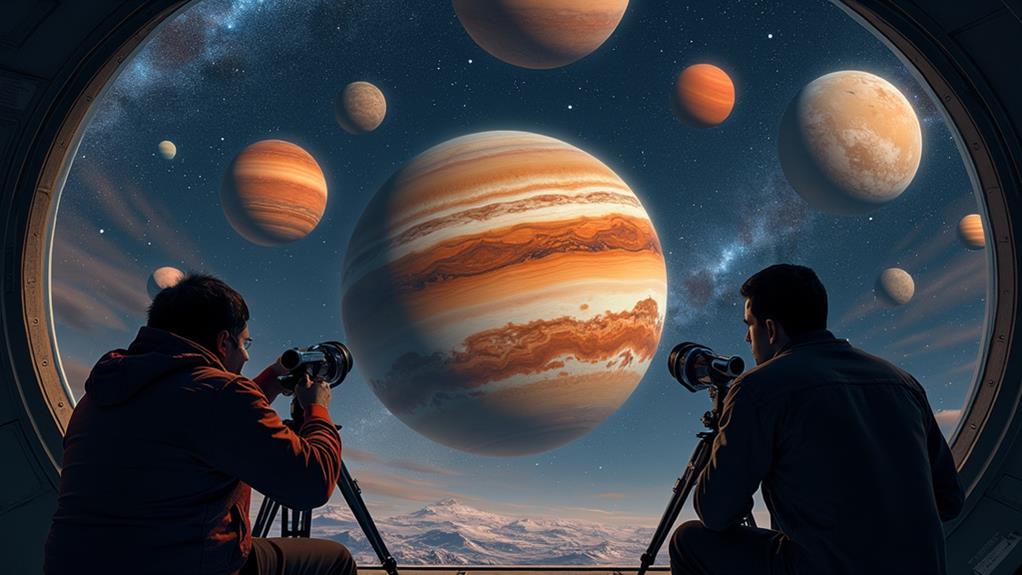
Examining the composition and characteristics of these celestial bodies sets the stage for understanding their fascinating histories. The finding of moons orbiting dwarf planets like Pluto, Eris, and Haumea has been a significant milestone in astronomy. Pluto's moons, including Charon, Nix, and Hydra, were initially uncovered in 1978 and 2005. Charon, the largest, is nearly half the size of Pluto, making it a unique celestial body worth studying.
The naming of these moons often draws from mythology, adding a layer of cultural significance. Charon is named after the ferryman of Hades, while Nix and Hydra reflect themes from Greek mythology. Likewise, Eris's moon, Dysnomia, identified in 2005, is named after the Greek goddess of lawlessness, complementing Eris's association with discord. Haumea's moons, Hi'iaka and Namaka, take their names from Hawaiian mythology, enriching the narrative of these distant worlds.
Advances in telescopic technology have played an essential role in the identification of these moons. As telescopes become more powerful, they allow you to observe these distant celestial bodies with greater detail, shedding light on their orbits, compositions, and the fascinating stories behind their naming.
Comparative Analysis With Major Planets
Dwarf planets and their moons offer a fascinating contrast to the major planets and their extensive satellite systems. When you compare them, several key differences emerge that highlight the unique nature of dwarf planet moons.
- Size Relationships: Unlike the major planets, whose moons vary widely in size, dwarf planets like Pluto have moons with notable size relationships. For instance, Pluto's moon Charon is almost half its size, a stark contrast to the smaller and more numerous moons of Jupiter and Saturn.
- Number of Moons: Major planets often boast dozens, if not hundreds, of moons. In contrast, dwarf planets typically have fewer satellites. Pluto, for example, has just five known moons, whereas gas giants like Jupiter have over 70.
- Orbital Dynamics: The orbits of dwarf planet moons are often more eccentric and chaotic. Eris's moon Dysnomia showcases this with its irregular orbit, unlike the relatively stable orbits observed around major planets.
- Kuiper Belt Influence: Dwarf planets reside in the Kuiper Belt, which greatly impacts their moons' characteristics. The moons of dwarf planets reveal insights into this distant region's conditions and materials, differing from the diverse environments influenced by the major planets' gravitational forces.
These differences underscore why dwarf planet moons are so unique compared to those orbiting major planets.
Future Exploration and Studies
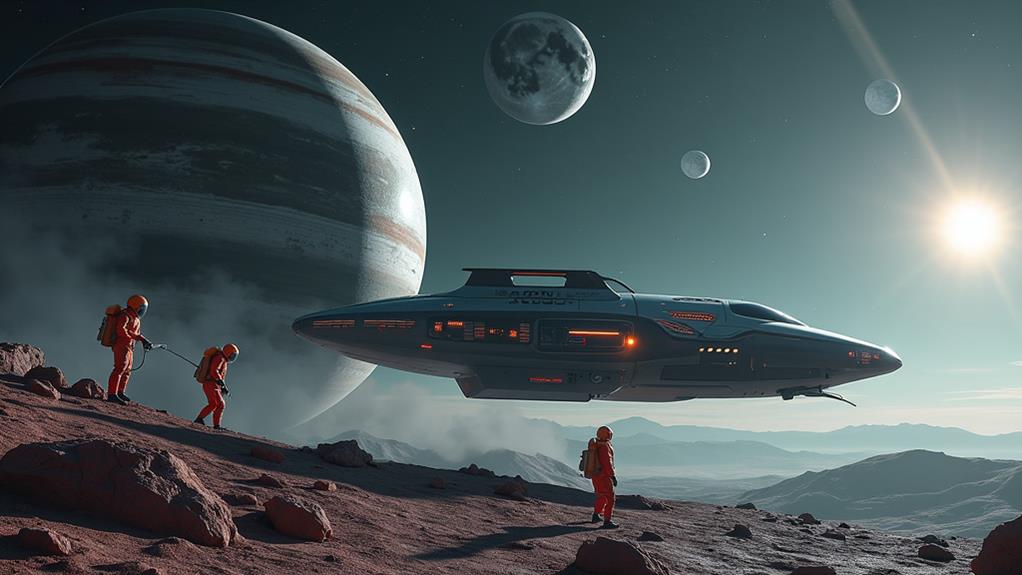
As we look to the future, the exploration of dwarf planets and their moons promises to reveal many mysteries about our solar system. Future exploration missions, like NASA's New Horizons, are expected to provide detailed data on Pluto and its moons, enhancing our understanding of their unique characteristics and formation. The James Webb Space Telescope, along with other advanced observational technologies, will uncover more about the moons of distant dwarf planets in the Kuiper Belt.
Ongoing surveys in the trans-Neptunian region could identify new dwarf planets and their moons, shedding light on their orbital dynamics and interactions. These surveys will be essential in understanding how these celestial bodies influence each other and the broader solar system. Research into the geological features of moons orbiting dwarf planets such as Haumea and Eris is aimed at revealing the processes that drive their development and evolution.
International collaboration among space agencies will be key to future missions, ensuring a thorough study of dwarf planets and their moons. By pooling resources and expertise, these missions promise to deepen our understanding of the solar system's history and dynamics, offering invaluable insights into the origins and evolution of these fascinating celestial bodies.
Frequently Asked Questions
What Makes a Dwarf Planet Different From a Moon?
You might wonder what makes a dwarf planet different from a moon. Dwarf planet classification sets them apart because they orbit the Sun, not other celestial bodies. Unlike moons, their orbital dynamics involve independent paths and they can't clear debris. Gravitational interactions in moon formation processes bond moons to planets, but dwarf planets exist in a distinct celestial hierarchy, maintaining their own orbits and interacting differently within the solar system.
What Is Unique About Dwarf Planets?
Dwarf planets are unique due to their size classification, fitting between full-sized planets and smaller bodies. Their orbital characteristics often include an elliptical path far from the Sun. You'll find varied surface compositions, from icy to rocky terrains. Some have thin atmospheric conditions. Their revelation history, like Pluto's in 1930, fascinates astronomers. Each dwarf planet tells a different story about the solar system's formation and evolution.
What Is the Only Dwarf Planet With No Moon?
Imagine studying Haumea's moons and Eris' moon; you'd notice how unique they are. Now, think about Ceres. Unlike Pluto's moon or Makemake's characteristics, Ceres stands out as the only dwarf planet with no moon. Ceres' uniqueness is due to its relatively small size and weak gravitational influence, making it unable to capture a moon. Identified in 1801, it's the largest object in the asteroid belt between Mars and Jupiter.
Why Do the Planets Have Different Moons?
Planets have different moons because of variations in planetary formation and gravitational influences. Each planet's unique birth and evolution shape its moon characteristics. Gravitational capture and collisions contribute to celestial dynamics, creating moons with diverse compositions and sizes. Orbital mechanics also play a significant role, determining how moons are retained or lost. These factors together explain the rich variety of moons across the solar system.

